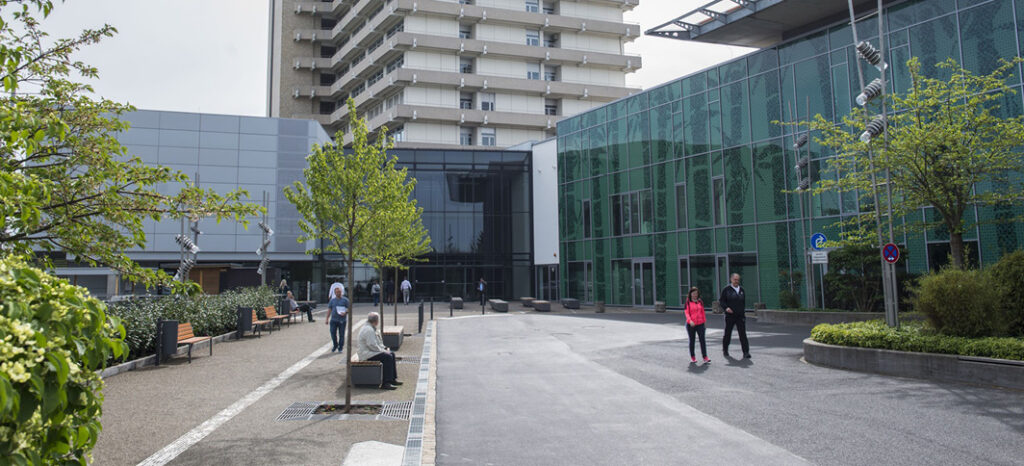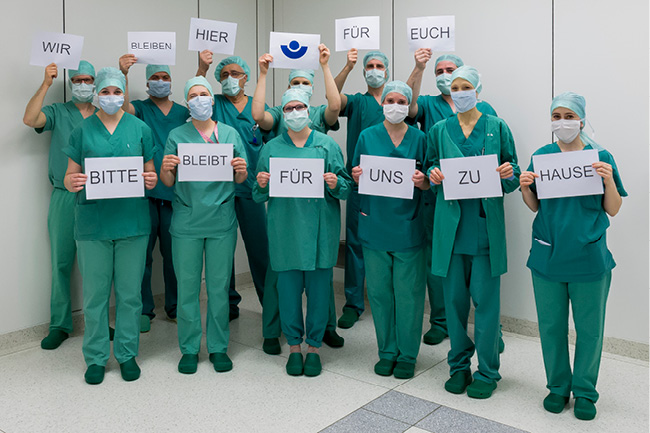In mid-March 2020, the first wave of COVID-19 confronted Germany with full force. Today, we are in the middle of the second, more vicious – in terms of numbers – wave. Nothing we have ever seen is in any way similar to the ongoing COVID-19 pandemic. Ebola did not reach our borders, the 2009 flu pandemic, including the new strain known as swine flu, caused “only” around 85,200 cases and 30 deaths in Germany.
Before the novel coronavirus hit us in Germany, the conditions in various countries, particularly the pictures from Italy and Spain, caused alarm and immediately put us in crisis-management mode, giving us a bit of preparation time. At our hospital,*1 we activated our already-defined crisis task force in early March. This included the hospital board, hygiene doctor, technical director, and quality management. Initially, we met daily online; currently, we meet once a week. Furthermore, during the first wave, the CEOs of all hospitals that belong to our company met online every day with our headquarters and their experts in Berlin.

It is worth noting that each hospital in Germany has its individual pandemic plan, as part of a comprehensive plan of a city and the various states, and in accordance with official health guidelines. At the local level, we are embedded in Frankfurt’s crisis task force that coordinates the work between hospitals and health bodies and other states or countries. ICU and ventilating capacities are uploaded daily on a nationwide platform to coordinate capacities and prevent the collapse of hospitals.
“It is well known that coronaviruses generally do not lead to long immunity. On average, it is one year for the normal ‘corona cold viruses.”
Professor Sandra Ciesek, director of the Institute of Medical Virology at the University Hospital Frankfurt
The number of decisions we make and the volume of information that arrives from the official bodies is immense. We are being provided with input on all aspects of the novel coronavirus and on new or altered laws and regulations. Simultaneously, many existing regulations are being put on hold, enabling hospitals to focus on and better deal with the tremendous new challenge. The most concise piece of information, however, was a letter we received on March 13, 2020, from the federal health minister, Mr. Jens Spahn, who, in an unusual manner, addressed the hospital heads directly. Referring to the alarming situation in Italy, he asked us (then formally requested per decree) to postpone all medically postponable treatments and surgeries. This aimed to create capacities for COVID-19 patients, enable adequate health care, and avoid a collapse of the health care system, as seen in neighboring countries – a main goal pursued diligently until today. Furthermore, Mr. Spahn asked us to double our ICU ventilation capacities. We currently no longer apply the first part of the plan of medical-treatment cancellations, at least so far.

The reactivatable plan to restructure the hospital to meet the needs of the pandemic entailed a number of measures, the first of which concerned safety. We immediately closed down unsuitable facilities such as group-therapy units, medical pools, and the cafeteria, offering alternative services with hygienically packed food. We made sure to shield every contact point, such as reception desks, with plexiglass. The option of working from home for administrative staff was promptly introduced, and all nonessential activities, such as training sessions and conferences, were halted. We altered visiting regulations in accordance with state requirements. A main task was to define and regularly update a comprehensive testing strategy for patients and staff, recently adding antigen*2 and pool testing*3 to the PCR-test, which remains the gold standard. In our hospital, we decided against antibody tests. Currently, we test every patient before admission or as a point of care in the emergency room.
As requested by the government and during the first wave only, the chief doctors decided which treatments could be postponed; cancellations were processed in June. At the same time, guidelines for diagnostics and therapy for the new disease were issued and are regularly updated. Training staff members simultaneously for hygiene and other measures was a priority. In order to reduce contact, videos were produced and streamed on the intranet.

Another preventive measure was implementing a new entrance to the emergency rooms with a “sorting area” to pre-assess self-referrals while correspondently activating the fever clinic. Here “suspected cases” are referred and, if confirmed, they are transported in a dedicated lift to the isolation ward, which was designed for this purpose, meeting specific hygiene demands. We introduced screening for outpatients via phone prior to fixing an appointment; furthermore, we coordinated with emergency services on safety measures prior to emergency deliveries.
The ongoing worldwide shortage – to varying degrees – of personal protective equipment (PPE) means that securing PPE continues to be one of the main challenges. In addition to PPE, we purchased special equipment for COVID-19 patients (e.g., shielded transporters). An exchange platform on available PPE with affiliated hospitals was created to bridge emerging bottlenecks.
Leading scientists in Germany, along with many of their colleagues worldwide, strongly oppose the idea of focusing only on the protection of the elderly and other at-risk and vulnerable groups while the rest of society returns to business as usual – aiming to achieve herd immunity during the corona pandemic. Too many factors make this strategy unfeasible.
At the same time, matters such as expanding capacity for a potential increase in deaths (cold rooms) – which gladly, we have not yet needed – had to be taken care of. Ethical guidelines for borderline situations and triage for our doctors on the front line were issued in accordance with guidelines of des Deutschen Ethikrats (German Ethics Council) – and which, fortunately, we have not yet needed in Germany.
As requested, we doubled the ICU and ventilation capacities, including building up a new area, while securing extra reserves of medical gases. For this purpose, we trained medical staff with related expertise for deployment to the expanded ICU. Likewise, we trained backup teams for other critical areas in case of increased incidents of sickness.
With changes taking place at such a breathtaking pace, we put special attention on regularly informing the staff members via intranet and offering support services such as virtual professional counseling.
Currently, the number of persons in Germany who test positive for COVID-19 is rapidly increasing at rates that are explained not only by expanded testing. Hospital capacities in some areas are becoming critical. Mainly, we are facing a shortage in medical staff, which hinders our use of the expanded capacities. Activating trained staff for COVID-19 care would mean reducing the regular treatment of other patients. Furthermore, testing capacities are getting tight, as the health bodies are partly overburdened with the once excellently performed job of tracking. Thus, the national testing strategy is currently being altered. A partial lockdown for four weeks has been implemented for November that entails some closures and a series of rules that apply especially to social and cultural fields and defines the number of private contacts allowed at one time. There is the hope that we might still manage to flatten the curve, as we did in the spring. The reported R-values,*4 one of several indicators, were stable well above 1 throughout October; fortunately, they reached 0.88 on November 10, 2020, falling from 1.10 on the day before, which indicated a steady downward trend over a few days, according to the Robert Koch Institute.*5 A value of < 1 is the targeted level. A comparison: the lowest value reached since March 2020 was around 0.6, the highest 2.76.
The mortality rate per million inhabitants is, as of today, 126, ranking 31st in Europe and 72nd in the world.*6 Germany managed to flatten the curve during the first wave and is shown to generally be doing well in international and European comparisons. The reasons are numerous: a mix of potential statistical distortions and factual differences. The latter includes the strategy of early, quick testing and isolating positive cases; the prevailing decentralized, flexible federal structures; a graduated health system (with health departments testing outpatients only seeking to be tested for COVID-19, not the hospitals); a well-structured hospital system; and, according to my observation, a general culture that is perceptive and ready for commitment and “acting reasonably,” not to forget the crucial factor of general trust in the current government and its leadership. A recent study showed that 80 percent of the population supports the government’s measures in dealing with the pandemic.
In addition to requiring effective crisis management and dealing with immediate, urgent needs, the current situation calls on us as intelligent individuals, institutions capable of continuous learning, and empowered societies to seize this historic occasion for change as a fundamental duty in light of this catastrophic event. Evolution teaches us: those who adapt survive!
On November 9, 2020, the world received the encouraging news of a breakthrough in developing the first vaccine against COVID-19 by BioNTech and its partner Pfizer. Many other candidates from numerous countries are expected to be following soon. In this regard, there are many important issues to be dealt with, such as fair access to the vaccines for all countries and setting the right priorities in each country as to who should get it first. Vaccination centers are now being built here to prepare for this challenging task. The current plan is to start with risk groups, members of the medical sector, and persons with intensive contacts. One of the most renowned virologists in Germany, Professor Christian Drosten,*7 the chair and director of the Institute of Virology at the Charité Hospital in Berlin, explained that the pandemic, seen at a global level, has “only now really started.” According to Drosten, the approval of a vaccine does not immediately solve the problem, due to logistic challenges. “It might be a job for the entire year 2021,” he predicted.
So where do we go from here?
Leading scientists in Germany and worldwide have strongly opposed the idea of focusing only on the protection of the elderly and other risk groups, while the rest of society returns to business as usual – aiming to achieve herd immunity. It is not possible to completely shield the elderly, they argue. On the other hand, there are many at-risk patients in the younger age groups, and we are currently seeing in our ICUs young patients with no underlying diseases. According to a recent statement by Angela Merkel, a third of the German population can be considered at-risk regarding COVID-19. Her statement was endorsed by several experts.
Uncontrolled contamination would thus lead eventually to an escalating increase in deaths because risk groups are far too numerous, heterogeneous, and partly unrecognized to actively shield them. The increased risk of severe COVID-19 progression occurs with many factors such as obesity, diabetes, cancer, renal insufficiency, chronic lung disease, liver disease, and stroke, as well as following transplants and during pregnancy. A possible complication for survivors of COVID-19 disease is the so-called “long COVID” syndrome, a term that summarizes various late damages to the respiratory, vascular, and nervous systems or other organs, severely restricting quality of life, the ability to work, and probably life expectancy.*8
The currently imposed mini-lockdown, as described above, which is considered a circuit breaker, intends to prevent the overwhelming of the health care system. It is not the preventive measure that scientists prefer (see below) but rather a compromise that attempts to keep a balance in efforts to save both the economy and public health. In a popular, award-winning podcast, Professor Drosten*9 used the following imagery to describe the idea of a mini-lockdown(s) as a circuit breaker: “It’s like a truck rolling down a mountain. Suppose we drive down a mountainside with a heavy truck that cannot stop, and we know that we will fly off the curve. The brakes are broken, and we are allowed to step on them only for five seconds. What to do? It will not be enough to pull the brakes once, we have to do it every few hundred meters. And we must do it early on, while we are still driving slowly downhill.” Accordingly, several mini-lockdowns that are spread over a long period of time are a potential measure to prevent rapid spread “until spring, when the situation gets better again, a vaccine is available, and temperatures rise again,” Drosten suggested. “The advantage of such a circuit-breaker over a more diffuse general lockdown, as was imposed in Germany in the spring, is that everyone knows from the outset: it is temporary. This way, everyone can adjust to it,” he concluded.
After a mini-lockdown, it is hoped that the number of new infections would be significantly reduced, allowing the system to better manage case-tracking again. This method is helpful, however, only if a certain threshold of infection numbers is not exceeded.
Regarding the much-debated school openings, the current consensus is to keep them open, as their closure in the spring of 2020 caused much controversy. Currently, schools are implementing various creative measures, from dividing larger groups to prevent super-spreader events to hybrid classes and applying – in addition to known hygiene rules – new technologies such as ventilation machines, recently designed for the purpose, or CO2 measuring devices that indicate when it is time to ventilate!
As a number of lessons have been learned, experts speak of another consensus: the novel coronavirus – as stated in the theme of TWiP’s current issue – is here to stay. We must learn to live with it. Eventually, vaccines will be available and, hopefully and successfully, will reach all parts of the world. We must rely on eventually having better medicines. We will learn to take the vaccine (the durability of which is yet unknown) in the required rhythm. Those who fall sick could then enjoy adequate treatment. Moreover, the experience we are gathering and the measures we will have taken will be a valuable reference and always “reactivatable.”
Beyond the health issue (and the socio-economic impact not dealt with here), there is the emerging question as to how our lives will be organized in the aftermath of the crisis. Zukunftsinstitut (Future Institute)x has outlined four potential scenarios: Total Isolation, System Crash, Neo-Tribes, and Adaptation. I will depict only the fourth scenario here.
Scenario 4: Adaptation
The world is learning and emerges stronger from the crisis. We adapt better to the circumstances and are more flexible in dealing with change. The global economy continues to grow but at a much slower pace, partly showing stagnation. Companies in such environments need new business models to become more independent of growth. This automatically raises the question of the purpose of economies: is it the constant striving for more profit? Alternatively, perhaps better, we find solutions that are socially and ecologically more advantageous for all stakeholders. One thing is clear: our pursuit of and striving towards the objective of humanity’s collective survival of this crisis helps us reconcile differences and treat each other with care.
*1 Berufsgenossenschaftliche Unfallklinik (BGU) Frankfurt.
*2 Antigen tests detect viral proteins expressed on the outer surface of the coronavirus. Antigens, a term for any foreign substance, such as a virus or bacteria, are recognized by the body to induce an immune response to fight off infection. These tests are less accurate than PCR tests.
*3 In the so-called pool tests, not one sample is examined individually for the coronavirus. A test of combined smears of several, usually ten, persons is made (pools). If the test is negative, all ten people in the pool are also considered negative. If the test is positive and the virus was detected in the pool sample, the ten samples must be analysed individually to determine the infected person.
*4 The reproduction number, or R-value, indicates how many other people an infected person infects. For example, at a value of 1.3, 10 infected people infect an average of 13 more people.
*5 The German federal government agency for disease control and prevention.
*6 Worldometers.info.
*7 Prof. Drosten is also the director of the Department of Virology of “Labor Berlin,” the largest laboratory in Europe. Some of his research focuses on emerging viruses. He was one of the co-discoverers of the coronavirus SARS-CoV in 2003. For the coronavirus SARS-CoV-2, the research group led by Drosten developed a test that was made available worldwide in mid-January 2020.
*8 Elizabeth J. Wiliamson, et al, “Factors associated with COVID-19-related death using OpenSAFELY,” Nature, July 2020, available at https://www.nature.com/articles/s41586-020-2521-4.
*9 The WHO requested to have the podcast translated for world accessibility, but Prof. Drosten declined, explaining that a translation of such content bears the high risk of misinterpretation or faulty reproduction, which might cause much harm. For those who understand German, I strongly recommend listening to it. https://www.ndr.de/nachrichten/info/Coronavirus-Update-Der-Podcast-mit-Christian-Drosten-Sandra-Ciesek,podcastcoronavirus100.html.
*10 “The Corona Effect: Four Future Scenarios for the Economy and Society” (in German), available at https://www.zukunftsinstitut.de/artikel/der-corona-effekt-4-zukunftsszenarien/.


